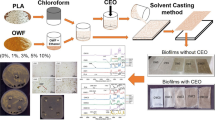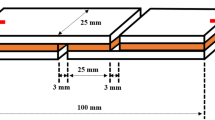Abstract
The technological, thermal, and antimicrobial properties of biocomposite films produced from polylactic acid (PLA) and thermally treated wood flour with in situ generated nanosilver particles (AgNPs) using a bio-reduction method. The extracts of fresh leaves of the phenolic-rich Oriental sweetgum (Liquidambar orientalis) tree were used as the reducing agent for silver ions. Six different formulations of the mixed raw materials were extruded in the co-rotating twin screw extruder. The PLA bicomposite films at the 5 and 10 wt% loading levels of wood flour were produced by a hot press method from the following six formulations: (a) thermally treated wood + leaf extract + AgNO3, (b) untreated wood + leaf extract + AgNO3, (c) thermally treated wood + AgNO3, (d) untreated wood + AgNO3, (e) thermally treated wood, (f) untreated wood, and (g) neat PLA. All biocomposite films produced with the untreated/treated wood flour at 5 and 10 wt% loading levels of wood flour showed better tensile modulus than the neat PLA specimens. In general, the tensile strength of the biocomposites was negatively affected by the increased content of the wood flour. The spectra obtained from scanning electron microscopy (SEM) equipped with energy-dispersive X-ray spectroscopy (EDX) showed the silver nanoparticles in the wood particles. The results showed that the biocomposite films produced with PLA and wood flour modified using silver nitrate and leaf extract had the highest tensile modulus. It was observed that the leaf extract treatment had a positive effect on the tensile properties of the biocomposite films at 10 wt% content of wood flour. The remarkable antimicrobial results was obtained by the prepared biocomposites treated with gram positive and gram negative clinical pathogens at maximum zone of clearance 2.6 mm treated with E. coli bacteria.







Similar content being viewed by others
References
Ayrilmis N, Ashori A (2015) Alternative solutions for reinforcement of thermoplastic composites. In: Campilho R (ed) Natural fiber composites. CRC Press, Boca Raton, pp 65–92
Ayrilmis N, Jarusombuti S, Fueangvivat V, Bauchongkol V (2011) Effects of thermal treatment of rubberwood fibres on physical and mechanical properties of medium density fibreboard. J Trop Forest Sci 23:10–16
Duran N, Duran M, Jesus MB, Seabra AB, Favaro WJ, Nakazato G (2016) Silver nanoparticles: a new view on mechanistic aspects on antimicrobial activity. Nanomed Nanotechnol 2:789–799. https://doi.org/10.1016/j.nano.2015.11.016
Belgacem MN, Gandini A (2005) The surface modification of cellulose fibres for use as reinforcing elements in composite materials. Compos Interface 12:41–75. https://doi.org/10.1163/1568554053542188
Thiagamani SMK, Rajini N, Siengchin S, Rajulu AV, Hariram N, Ayrilmis N (2019) Influence of silver nanoparticles on the mechanical, thermal and antimicrobial properties of cellulose-based hybrid nanocomposites. Compos Part B 165:516–525. https://doi.org/10.1016/j.compositesb.2019.02.006
Jiang ZJ, Liu CY, Sun LW (2005) Catalytic properties of silver nanoparticles supported on silica spheres. J Phys Chem B 109:1730–1735. https://doi.org/10.1021/jp046032g
Gudimalla A, Jose J, Varghese RJ, Thomas S (2020) Green synthesis of silver nanoparticles using Nymphae odorata extract incorporated films and antimicrobial activity. J Polym Environ. https://doi.org/10.1007/s10924-020-01959-6
Muthulakshmi L, Rajini N, Nellaiah H, Kathiresan T, Jawaid M, Rajulu AV (2017) Experimental investigation of cellulose/silver nanocomposites using in situ generation method. J Polym Environ 25:1021–1032. https://doi.org/10.1007/s10924-016-0871-7
Butkus M, Labare M, Edling L (2003) The efficacy of silver as a bactericidal agent: Advantages, limitations and considerations for future use. J Water Supply Res Technol 52:407–415. https://doi.org/10.2166/aqua.2003.0037
Smiechowicz E, Niekraszewicz B, Kulpinski P, Dzitko K (2018) Antibacterial composite cellulose fibers modified with silver nanoparticles and nanosilica. Cellulose 25:3499–3517. https://doi.org/10.1007/s10570-018-1796-1
Xu Y, Li S, Yue X, Lu W (2018) Review of silver nanoparticles (AgNPs)-cellulose antibacterial composites. BioRes 13:2150–2170. https://doi.org/10.15376/biores.13.1.Xu
Guo L, Yuan W, Lu Z, Li C (2013) Polymer/nanosilver composite coatings for antibacterial applications. Colloid Surf A 439:69–83. https://doi.org/10.1016/j.colsurfa.2012.12.029
Li S, Shen Y, Xie YuX, Qiu L, Zhang L, Zhang O (2007) Green synthesis of silver nanoparticles using Capsicum annuum L. extract. Green Chem 9:852–858. https://doi.org/10.1039/B615357G
Sila MJ, Nyambura MI, Abong’o DA, Mwaura FB, Iwuoha E, (2019) Biosynthesis of silver nanoparticles from Eucalyptus corymbia leaf extract at optimized conditions. Nano Hybrid Compos 25:32–45. https://doi.org/10.4028/www.scientific.net/NHC.25.32
Dubey M, Bhadauria S, Kushwah B (2009) Green synthesis of nanosilver particles from extract of Eucalyptus hybrid (safeda) leaf. Dig J Nanomater Biostruct 4:537–543
Sarac N, Sen B (2014) Antioxidant, mutagenic, antimutagenic activities, and phenolic compounds of Liquidambar orientalis Mill. var. orientalis. Ind Cro Prod 53:60–64. https://doi.org/10.1016/j.indcrop.2013.12.015
Muthulakshmi L, Rajini N, Nellaiah H, Kathiresan T, Jawaid M, Varada Rajalu A (2017) Preparation and properties of cellulose nanocomposite films with in situ generated copper nanoparticles using Terminalia catappa leaf extract. Int J Biol Macromol 95:1064–1071. https://doi.org/10.1016/j.ijbiomac.2016.09.114
Sivaranjana P, Nagarajan ER, Rajini N, Jawaid M, Varada Rajulu A (2017) Cellulose nanocomposite films with in situ generated silver nanoparticles using Cassia alata leaf extract as a reducing agent. Int J Bio Macromol 99:223–232. https://doi.org/10.1016/j.ijbiomac.2017.02.070
Chandran SP, Chaudhary M, Pasricha R, Ahmad A, Sastry M (2006) Synthesis of gold nanotriangles and silver nanoparticles using aloe vera plant extract. Biotechnol Prog 22:577–583. https://doi.org/10.1021/bp0501423
Leela A, Vivekanandan M (2008) Tapping the unexploited plant resources for the synthesis of silver nanoparticles. Afr J Biotechnol 7:3162–3165
Li S, Shen Y, Xie A, Yu X, Qiu L, Zhang L, Zhang Q (2007) Green synthesis of silver nanoparticles using Capsicum annuum L. extract. Green Chem 9:852–858
Müller AJ, Avila M, Saenz G, Salazar J (2014) Chapter 3: crystallization of PLA-based materials. In: Jimenez A, Peltzer M, Ruseckaite R (eds) Poly(lactic acid) science and technology: processing, properties, additives and applications. RSC Publishing, London, pp 66–98
Kuciel S, Mazur K, Hebda M (2020) The influence of wood and basalt fibres on mechanical, thermal and hydrothermal properties of PLA composites. J Polym Environ 28:1204–1215. https://doi.org/10.1007/s10924-020-01677-z
Petinakis E, Yu L, Edward G, Dean K, Liu H, Scully AD (2009) Effect of matrix–particle interfacial adhesion on the mechanical properties of poly(lactic acid)/wood-flour micro-composites. J Polym Environ 17:83–94. https://doi.org/10.1007/s10924-009-0124-0
Hinestroza J, Netravali AN (2014) Section 3: wood/biopolymer/nanoclay composites. In: Netravali AN, Hinestroza J (eds) Cellulose based composites: new green nanomaterials. Wiley, Weinheim
Le Guen M-J, Hill S, Smith D, Theobald B, Gaugler E, Mayer-Laigle BA (2019) Influence of rice husk and wood biomass properties on the manufacture of filaments for fused deposition modeling. Front Chem 7:735. https://doi.org/10.3389/fchem.2019.00735
Ayrilmis N, Jarusombuti S, Fueangvivat V, Bauchongkol P (2011) Effect of thermal-treatment of wood fibres on properties of flat-pressed wood plastic composites. Polym Degrad Stabil 96:818–822. https://doi.org/10.1016/j.polymdegradstab.2011.02.005
Ayrilmis N, Büyüksarı U (2011) Enhancement of dimensional stability of biocomposites containing agricultural waste by heat-treatment method. Drying Technol 29:591–598. https://doi.org/10.1080/07373937.2010.518328
Tran LQN, Fuentes CA, Dupont-Gillain C, Van Vuure AW, Verpoest I (2013) Understanding the interfacial compatibility and adhesion of natural coir fibre thermoplastic composites. Comp Sci Techn 80:23–30. https://doi.org/10.1016/j.compscitech.2013.03.004
Pillin I, Montrelay N, Bourmaud A, Grohens Y (2008) Effect of thermo-mechanical cycles on the physico-chemical properties of poly(lactic acid). Polym Degrad Stab 93:321–328. https://doi.org/10.1016/j.polymdegradstab.2007.12.005
Zenkiewicz M, Richert J, Rytlewski P, Moraczewski K, Stepczynska M, Karasiewicz T (2009) Characterisation of multi-extruded poly(lactic acid). Polym Testing 28:412–418. https://doi.org/10.1016/j.polymertesting.2009.01.012
Sanchez FAC, Boudaoud H, Hoppe S, Camargo M (2017) Polymer recycling in an open-source additive manufacturing context: mechanical issues. Add Manuf 17:87–105. https://doi.org/10.1016/j.addma.2017.05.013
Kwon M, Lee SC, Jeong YG (2010) Influences of physical aging on enthalpy relaxation behavior, gas permeability, and dynamic mechanical property of polylactide films with various d-isomer contents. Macromol Res 18:346–351. https://doi.org/10.1007/s13233-010-0410-7
Müller P, Imre B, Bere J, Moczo J, Pukanszky B (2015) Physical ageing and molecular mobility in PLA blends and composites. J Therm Anal Calorim 122:1423–1433. https://doi.org/10.1007/s10973-015-4831-6
Naeem Iqbal HM, Sungkapreecha C, Androsch R (2017) Enthalpy relaxation of the glass of poly (l-lactic acid) of different d-isomer content and its effect on mechanical properties. Polym Bull 74:2565–2573. https://doi.org/10.1007/s00289-016-1854-5
Sohel MA, Mondal A, Sengupta A (2018) Effect of physical aging on glass transition and enthalpy relaxation in PLA Polymer filament. In: Proceeding in International Conference RAMSB-18, Mangalore, pp.191–194
Muthulakshmi L, Rajalu AV, Kaliaraj GS, Siengchin S, Parameswaranpillai J, Saraswathi R (2019) Preparation of cellulose/copper nanoparticles bionanocomposite films using a bioflocculant polymer as reducing agent for antibacterial and anticorrosion applications. Compos Part B 175:107177. https://doi.org/10.1016/j.compositesb.2019.107177
Shrivastava S, Bera T, Roy A, Singh G, Ramachandrarao P, Dash D (2007) Characterization of enhanced antibacterial effects of novel silver nanoparticles. Nanotechnology 18:225103. https://doi.org/10.1088/0957-4484/18/22/225103
Acknowledgements
The authors would like to thank The Scientific and Technological Research Council of Turkey (TUBITAK) grants fellowships for international scientists/researchers ‟2221”-Fellowships for Visiting Scientists and Scientists on Sabbatical Leave (Grant Number: 1059B211800552-Rajini Nagarajan). The authors would like to thank Dr. Angela Balzano for SEM-EDX analysis of the specimens under financial support of Slovenian Research Agency (P4-0015).
Funding
The funding was supported by Türkiye Bilimsel ve Teknolojik Araştirma Kurumu (Grant No. 1059B211800552) and Javna Agencija za Raziskovalno Dejavnost RS (SI) (Grant No. P4-0015).
Author information
Authors and Affiliations
Corresponding authors
Ethics declarations
Conflict of Interest
No potential conflict of interest was reported by the authors.
Additional information
Publisher's Note
Springer Nature remains neutral with regard to jurisdictional claims in published maps and institutional affiliations.
Rights and permissions
About this article
Cite this article
Ayrilmis, N., Yurttaş, E., Durmus, A. et al. Properties of Biocomposite Films From PLA and Thermally Treated Wood Modified with Silver Nanoparticles Using Leaf Extracts of Oriental Sweetgum. J Polym Environ 29, 2409–2420 (2021). https://doi.org/10.1007/s10924-021-02065-x
Accepted:
Published:
Issue Date:
DOI: https://doi.org/10.1007/s10924-021-02065-x




